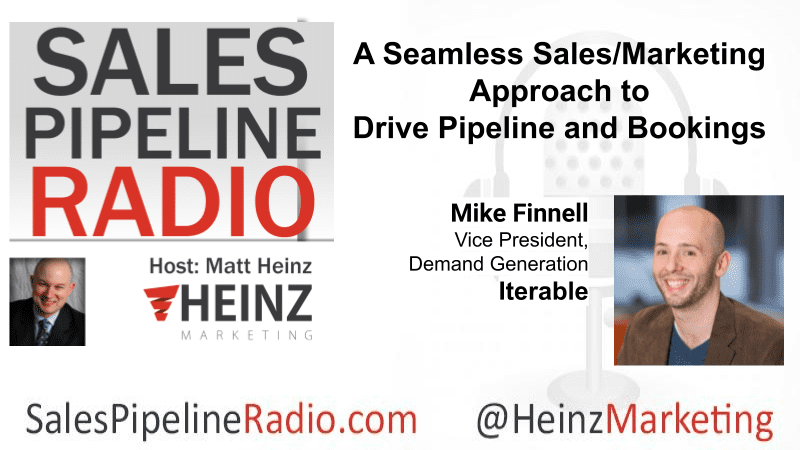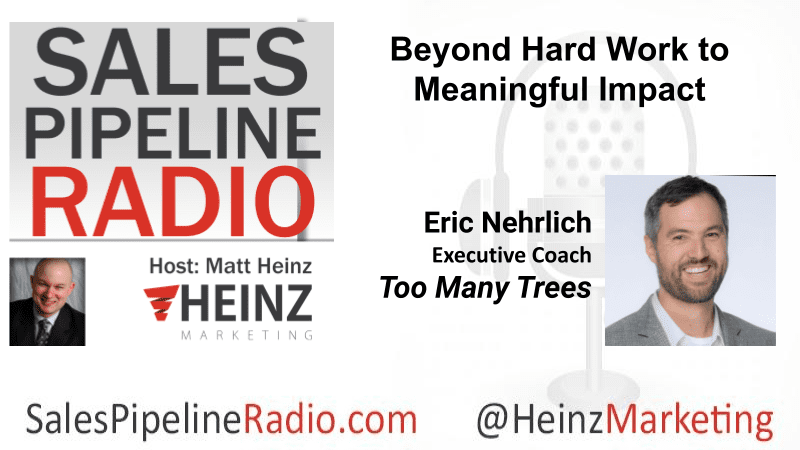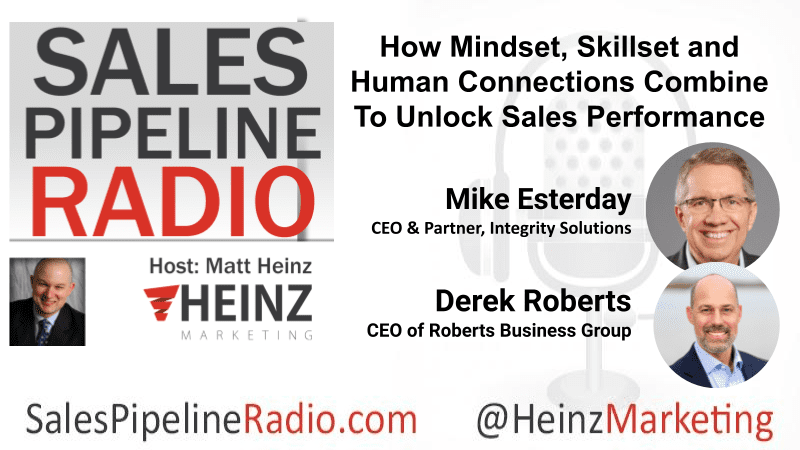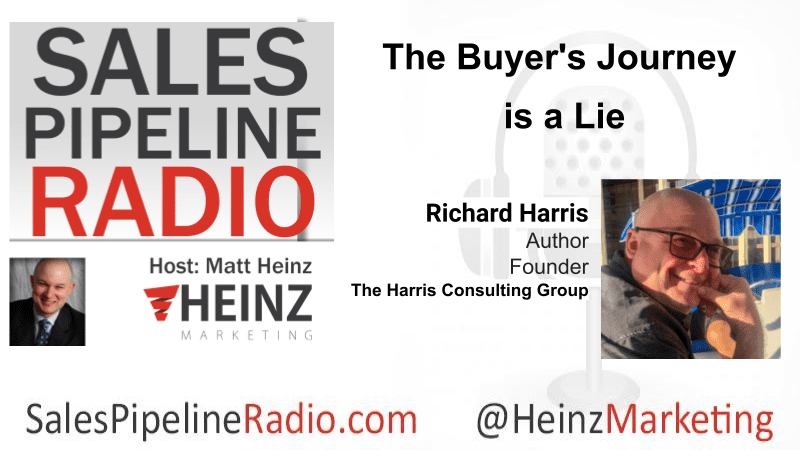Sales Pipeline Radio, Episode 356: Q & A with Mike Finnell

Summary
Matt interviews the best and brightest minds in sales and Marketing on Sales Pipeline Radio.
By Matt Heinz, President of Heinz Marketing
If you’re not already subscribed to Sales Pipeline Radio or listening live Thursdays at 11:30 am PT on LinkedIn (also on demand) you can find the transcription and recording here on the blog every Monday morning. The show is less than 30 minutes, fast-paced and full of actionable advice, best practices and more for B2B sales and marketing professionals.
We cover a wide range of topics, with a focus on sales development and inside sales priorities.
This week’s show is entitled, “A Seamless Sales/Marketing Approach to Drive Pipeline and Bookings“ and my guest is Mike Finnell, Vice President of Demand Generation at Iterable.
Tune in to Learn About:
- The importance of intentionally building in cross-functional rigor at the organization to help pipeline production and velocity.
- Why you must test and innovate to avoid becoming outdated in the current market.
- How and why to create a culture of vulnerability, acceptance, patience, and trust within the team.
Watch the video, listen in below and/or read the transcript below.
Matt: Alright, welcome everybody to another episode of Sales Pipeline Radio.
I’m very excited to have with us today, Mike Finnell. Thank you so much for joining us today.
Mike: Yeah, thanks for having me. I appreciate it.
Matt: We’ve had a lot of conversations given your role Iterable running revenue marketing, about the complexity of go to market today and where that has evolved from.
When we both started this, years ago at Dreamforce, there was a group I was invited to called Bald Force. I can’t make this up. I was invited to Bald Force and it was literally a bunch of bald guys having beer at a local brewery pub.
So I guess that’s a cohort.
Mike: Why do you bring that up to me?
Matt: I’m just stating facts. It’s just random facts. Cause I am bald, just me. I am bald. Gone are the days of filling out a form and sending that to sales. Gone are the days of having single threaded sales conversations and hoping that’s going to work.
The complexity of go to market for the seller and the buyer, it’s getting nuts. It keeps us employed, I guess. And so I’d love to have a conversation around what you’ve seen over the years of that complexity. And what can we do as go to market leaders to create more predictability out of that chaos?
Mike: Yeah. You know, it’s interesting. I had a friend of mine years back now, and I was going through a job transition, and I pinged her and said, Hey, who do you know discussion and I come from sales, and they said, get out of marketing, go back to sales.
It’s getting increasingly more difficult to actually do this because it’s so easy to show value now. And for me, I was like, well, hold on a second. That’s not a reason to get out of marketing. That’s the reason to stay in marketing. Right? So I think it has changed. I think there’s some really high-level changes that are interesting.
It’s funny cause we go back and forth, right? it wasn’t that many years ago we were only talking about marketing influence. And then it was like, you know, we have to tie directly to bookings and pipeline, which we absolutely do. And then we overcorrect it. And all we focused on is direct tie to attribution modeling that forced into pipeline and bookings.
And then we find ourselves in a position where we have to really focus on lo and behold influence in the holistic picture again. And I think that’s one of the biggest changes. I think what’s really interesting for me is it also wasn’t that long ago where it was like a sales and marketing octagon every day of the week.
And it’s not that anymore, right? I hate the term seat at the table, but this, marketing and sales as one go to market organization even if it’s not structured that way, but in unification is, I think trending for sure. And I think that’s what I’m blessed with where I’m at now.
And it’s what I’ve always subscribed to even though sometimes it’s looked at as me sticking my hand in someone’s cookie jar. And I think that’s been one of the most exciting changes is this conscious recognition of the fact that for us to go build this thing and be a fast-growing company, we can’t do it on our own.
It has to be the collective effort and the strategy aligned across really all parts of the organization, but specifically to go to market work broadly.
Matt: I think you’re right. And it’s easy to take for granted that position that you’re in to think about this cross functionally, to recognize that this is a team sport, right?
I think, maybe six, seven years ago, your role would have very clearly been more like, oh, this is demand marketing, or this is demand generation. The fact that you’re, thinking about this more from a revenue marketing standpoint, right? The fact that you’re thinking about this as a revenue responsible marketer, not just someone driving leads and top of pipeline is very, very different.
Talk about that mentality and since you’ve got the culture and environment internally, what are the components of that that are repeatable for other organizations?
Mike: It wasn’t that long ago that I worked for a CMO and he asked me to dig in on why leads weren’t being followed up with and I was more of an IC at this point, and then trying to force, if you will, for lack of a better term, sales to adopt some methodologies that would increase pace to S1, S2, S3, and man, I’m not gonna lie. I was uncomfortable cause I knew it was going to be the octagon that I mentioned.
I think that change is a conscious one, right? So I think there’s language that’s important. If I go back a couple of companies ago one of my buddies Jack Garippa, one thing we did a while back is we wanted to align that team– it was closely aligned and working great together, but we wanted to show this unified force. And I remember going into some big operational tempo meetings and we had to build this whole thing from scratch.
And we went in, we put sales and marketing together on how we represent this to the executive team. And I remember our CEO, I’m not going to say what he said, cause it may have been a swear, but he’s like, why did you guys put this together? And it was, we thought he was angry about it. And we told him do you not like it?
And he said, no, I just wish I had thought of this earlier in my career because this is how I should have been doing it then. And I think that was a good realization that this is the way it should be. And then that shifted the conversation. So I think language is important. Marketers chase attribution.
We are kind of programmed that way. We’re typically incentivized that way. So we’ll talk about marketing source pipeline. What I say to my team and more broadly is I don’t care– I mean, I care, but we don’t care about Marketing Source pipeline. We care about All Pipeline. The only time that Marketing Source pipeline as an attribution model matters is if there’s an issue and then we need to drill down anyway or for budgeting and we can solve that in other ways. Right? So this holistic focus and the language being around what are the goals of the business? How do we best support sales is important. So, what I try to get my teams to do is not talk– it’s probably painful sometimes– but not talk about just the marketing source pipeline. That’s a part of it, but I want to know what is all the pipeline? Where are there gaps, right? So if marketing is doing great, but we have a shortfall in SDR sourced pipeline or bookings, is there a way in which we can inflate that from, Marketing or from BD or whomever it is?
And I think that nomenclature, that conversation shifts it. And being in the trenches, if you will, with sales, you know, fighting the fight, if you will, for lack of a better term to get pipeline in, keep it moving and help go to bookings. And then the next step is it doesn’t end at bookings. Then it’s about how do we continue to wow our customer, make them happy, and see if they need more from us.
Matt: I love all that you’re saying here. We’re talking today with Mike Finnell. He’s the global vice president of demand generation for Iterable and we’re talking about really having that revenue mentality as a marketer.
And there’s jobs to be done along that process. And whether you’re marketing or sales or BD is it’s a team sport to do this well. I want to talk a little bit about this concept of marketing source pipeline because I think a lot of people interpret that as where did the lead come from?
And I think there’s a big difference between where the lead come from and where did the opportunity come from? Cause if you’re in a named account marketing role. You know the companies whether it’s a hundred companies or 2000 companies, you know the companies, you probably have a list of the people.
The job is not to generate net new leads. The job is to generate pipeline. And what I mean by that is to take people at the right company and get them interested enough to explore more, to get them committed to change as a buying committee, to want to actually move forward and learn more about your solution.
That isn’t generating the lead that is generating the opportunity– and I think changes the mindset and changes the prioritization of what marketing is doing. Curious to get your thoughts on that.
Mike: Yeah, I think it’s well said first. The concept of multi-threading is, I think a critical one and we can start that before we even break into the account, right? So if we’re looking at our database and we see that on average, our accounts have two contacts in each of them, we’ve got a massive problem because we know the average buying group in B2B has at least eight in a buying group. So we’ve got a contact gap.
So I think that’s one thing, but it’s also about the best approach to get into the account. If we’re only focusing on who sourced it, then we’re not playing as a team. We’re all chasing around individual goals, whereas we can now, we’ve got the luxury of an abundance of data. We can leverage that data to see what touch points actually increase engagement so we can do what demand generation, by the way, is supposed to do, which is generate demand and then capture it, not just capture demand, right? So we can get a holistic view on it. At the end of the day, I really don’t care if it was sourced by an SDR because they busted their butt to outreach it, or it was sourced by a demo request, or it was sourced because an AE had a free moment to do a cold call or it came from BD.
I care that we collectively got there. Everybody can touch on it to increase success because some of the data we do have shows that when we have marketing, BD, AEs and SDRs all working on the same account, they typically go through pipeline faster and they close at a higher rate because they’ve been brought on the journey from awareness to purchase more effectively.
Matt: Yeah, I agree. I want to talk about attribution here for a second cause the relationship sales and marketing is approved, but it’s still often emotional. And the emotional piece is something you can’t undersell here, right? We can build all the playbooks in the world.
We can build what we think is a better dashboard. But until robots sell to robots, which might be in the offing at some point, the humanity of people behind this is still part of this and Brent Adamson, who co-wrote The Challenger Sale, I’ve heard him often say that attribution is about affirmation, right?
And affirmation is emotional. Now I can tell you 14 different ways why I think that that approach to attribution is flawed, but it speaks to some of the tensions inside organizations that persist, that are man-made, that are artificial, that are real, but I think can be mitigated by really leaning in more on that team sport mentality of building and closing pipeline.
Mike: Yeah. To quote a friend of mine, Michael Brown, he would say, probably among the best BDR leaders in the business, by the way, but he would say that retention is okay, but when it becomes contention, we have a massive problem. So I think a little bit of tension between sales and marketing is okay,
right? That’s probably healthy. We’re holding each other accountable. When it turns to contention, that’s where the emotional stuff comes in and then people are entrenched and it’s really hard to overcome. Some of the stuff that I think we all hopefully are trying to do and I aspire to, and I probably fail it as much as I succeed, and maybe I succeed a little less to be honest with you, but it’s just getting this painful transparency, being completely open about the discussion, right? Which is uncomfortable to do depending on the organization, but we shouldn’t hold so much pride in how we built something to not be able to admit that we could do it better, right? And this constant state of improvement is important, but I will say that the open and transparent discussion is, I think one of those critical things that makes that easier and, there are no accusations, right? It’s just about this is a business problem and how do we fix it at a collective?
Something I’ve done at a few companies now, and this one is no different, is we have a good weekly call, cross functional group, literally sales leaders, marketing leaders, enablement leaders, operation leaders– just a being a good cross functional group. We don’t typically take it to the executive team on the C suite, but we all get together, talk about what’s trending in the business, and map out some ways in which we think we can go fix them.
And our ability to test, an idea quickly because you’ve got a cross functional group that can, lack of a better term, poo poo the idea. We make it better and then we can test it over the next week and see, did it have the results? So the goal is every week to solve a new problem or two and a year down the road, how much more efficient are we?
Matt: Yeah, it’s the mentality people bring to that is really, really important. It starts from the top. It starts from leaders that are willing to forego ego and share the praise, share the blame and realize that… I keep going back to this idea of the team sport, but also I think to be willing to embrace vulnerability.
I think Guy Kawasaki, who many people know as the Apple evangelist who continues to have great new ideas. His new book is called Think Remarkable. And what he’s done is he’s gone and he’s interviewed like 200 leaders and found out what are the commonalities among leaders that are really remarkable themselves and creating remarkable outputs.
And one of the commonalities is embracing vulnerability. And I bring that up here because it’s not just accepting what doesn’t stink. It’s accepting that there may not be a singular point of attribution, one team versus another one campaign versus another, but also accepting that failure is part of the process.
That when you do A B testing, B is always wrong. There’s a loser in that game every time. And so it’s not about failure. It’s about learning and being open to those conversations. I can’t tell you how many times I’ve sat in program reviews where the people that own certain programs are never willing to admit that something was wrong.
They want to look good. We all do. But if you’re not willing to face what wasn’t working to get better, then we can’t get better. And that’s a real emotional blocker that has to beled and evangelized and, lived from the top as well.
Mike: I would agree. There’s gotta be a willingness to change. Go back to when COVID hit and we all had our plans. I know I just went to COVID, it’s like sacrilege. But we all had our plans and then overnight they were completely decimated and we had to do everything from revamp, how we were going to go field marketing to recoup investments from organizations that we’re going to invest with in real time at an event– I think we learned from that hopefully that we’re going to get, pardon me, but we’re going to get shit wrong.
We’re just, we’re going to break some stuff along the way. And that is absolutely part of the process. I think seeing that from a leadership perspective too, by the way is super important for the next level of marketers coming up because if they’re coming up and not letting their teams have a little bit of leeway to fail at something, innovation is going to be stifled, right?
We’re not going to get anywhere. We won’t be growing like we need to if we can’t test and fail. And hopefully we’re failing fast and we don’t want to fail while we just spent $250,000, but on a $15,000, $20,000 test, it’s likely a worthwhile investment.
Matt: Well, and when we’re asking our teams to change how they work and how they go to market, when we’re no longer just sort of flinging leads across the board, we’re no longer just getting people to fill out forms. When we no longer care about the most leads at the most possible costs, when we may care about the opposite, I’m willing to spend two, three, four times as much money for the right leads.
That’s a different motion, is for some people, a different skill set. We have to as leaders create a place for them to pivot and to not have it right and perfect from the get-go. AI is going to accelerate this too, right? I mean, AI is already a phenomenal, phenomenal tool for people that know where to place it.
It is not an existential threat. If you look at what it can do now, what it’ll do moving forward and how you provide humanity to continue to do what we do best as humans with human brains, right? So I think as leaders, we need to set examples [00:14:00] with ourselves first and create that culture of vulnerability and acceptance and patience and trust.
I’ve seen so many companies lean into that and not only generate exponentially greater results, but create phenomenal teams and cultures, like just great places to work, to really have real impact on the organization and the purpose of those organizations fundamentally.
Mike: Our CEO, Jeff at Activate event, said, AI is not going to take your job, but the people that know how to use it will. And I think that’s a pretty good summation of it. I don’t think it hurts. I think it helps us scale the business and prioritize more strategic. And if I’m honest too, it’s a hell of a lot of fun. Over the summer we were doing
a ton of ad testing so we could learn fast. And we wanted to do some of it with AI. And I literally, for fun, drafted some copy in the voice of Zoolander and and sent that to– just an idea of like…
So it’s fun for creative brainstorming as well.
Matt: Yeah. That’s good. There’s so many advantages it already has and just like every day, every hour, it keeps getting better. So, I know we got to wrap up.As you look at the rest of this year, and as you think about this continued evolving complexity and, for some marketers that are still maybe in arts and crafts land, still locked in MQL land, what are things that individual contributors and marketing leaders can do to continue to elevate the revenue responsible impact and role of their job?
Mike: Yeah, I think first of all, we’re always going to have to be a bit in MQL land, like it is part of the funnel math, right? I mean, it’s just always going to be a part of it, but to your point if we’re up leveling the MQLs and we need a whole hell of a lot less of them, and we can build an efficiency through the cycle, right?
So, and I think that’s probably the biggest one. I think intentionally building in cross functional rigor at the organization is going to help pipeline production and then pipeline velocity full stop. Like that cross functional rigor and accountability, both to the go to market org and across it and back to marketing is a super helpful.
And then if you’re not testing stuff, if you’re not trying to innovate, in my opinion, you’re destined for failure, you’re going to become the dinosaur pretty quickly, especially in the current market.
Matt: I think that’s great advice. Well, thanks Mike Finnell. He’s the VP of Global Demand Gen for Iterable. Thanks for joining us today and sharing some of your thoughts. Appreciate it.
Mike: Yeah. Thanks for having me.
Matt: Thanks everyone for watching another episode. We’ll be back next week, 11:30 Pacific, 2:30 Eastern. This is Matt Heinz. Thanks for joining us on another episode of Sales Pipeline Radio. We’ll see you next time.
Listen to the Latest Episodes:
Matt interviews the best and brightest minds in sales and Marketing. If you would like to be a guest on Sales Pipeline Radio send an email to Sheena@heinzmarketing.com.
Sales Pipeline Radio was recently listed as a 30 Best Sales Management Podcasts
You can subscribe right at Sales Pipeline Radio and/or listen to full recordings of past shows everywhere you listen to podcasts! Spotify, iTunes, Blubrry, Google Play, iHeartRADIO, Stitcher and now on Amazon music. You can even ask Siri, Alexa and Google or search on Audible!



